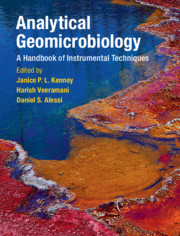Book contents
- Analytical Geomicrobiology A Handbook of Instrumental Techniques
- Analytical Geomicrobiology
- Copyright page
- Contents
- Contributors
- Foreword
- Part I Standard Techniques in Geomicrobiology
- Part II Advanced Analytical Instrumentation
- 2 The Application of Isothermal Titration Calorimetry for Investigating Proton and Metal Interactions on Microbial Surfaces
- 3 Potentiometric Titrations to Characterize the Reactivity of Geomicrobial Surfaces
- 4 Use of Multi-collector ICP-MS for Studying Biogeochemical Metal Cycling
- Part III Imaging Techniques
- Part IV Spectroscopy
- Part V Microbiological Techniques
- Index
- References
4 - Use of Multi-collector ICP-MS for Studying Biogeochemical Metal Cycling
from Part II - Advanced Analytical Instrumentation
Published online by Cambridge University Press: 06 July 2019
- Analytical Geomicrobiology A Handbook of Instrumental Techniques
- Analytical Geomicrobiology
- Copyright page
- Contents
- Contributors
- Foreword
- Part I Standard Techniques in Geomicrobiology
- Part II Advanced Analytical Instrumentation
- 2 The Application of Isothermal Titration Calorimetry for Investigating Proton and Metal Interactions on Microbial Surfaces
- 3 Potentiometric Titrations to Characterize the Reactivity of Geomicrobial Surfaces
- 4 Use of Multi-collector ICP-MS for Studying Biogeochemical Metal Cycling
- Part III Imaging Techniques
- Part IV Spectroscopy
- Part V Microbiological Techniques
- Index
- References
Summary
Multi-collector inductively coupled plasma mass spectrometry (MC-ICP-MS) is a powerful technique for the study of biogeochemical cycling of a variety of metals. The advantages of this technique include high ionization efficiency, low detection limits, and rapid analysis. It can produce highly precise and accurate elemental isotope compositions of natural and experimental samples, which can provide insights into the mechanisms of both biological and abiological processes in in natural environments. In this chapter, the operating principles of the instrument, purification of samples, interferences encountered, correction methods to eliminate the instrumental mass discrimination, and data analysis with respect to reliability and reproducibility are discussed. A case study is included that highlights the capability of MC-ICP-MS to infer mechanisms of Fe redox processes in an acidic oligotrophic lake using natural abundance of stable Fe isotopes.
- Type
- Chapter
- Information
- Analytical GeomicrobiologyA Handbook of Instrumental Techniques, pp. 93 - 118Publisher: Cambridge University PressPrint publication year: 2019
References
4.5 References
- 1
- Cited by



